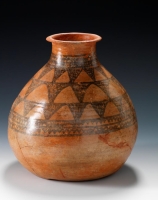
A Pottery Jar from the Dilmun Civilization is a circular-shaped archaeological artifact dating back to pre-Islamic times. It was used to store liquids and was discovered in burial sites south of Dhahran in the Eastern Province of the Kingdom of Saudi Arabia. The jar, registered under number 1946, is preserved at the National Museum in Riyadh City . History of the jar The archaeological jar dates back to approximately 1800 BCE, a period associated with the Dilmun civilization. The jar features a...
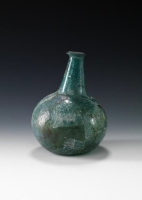
The Ancient Round Glass Bottle is an ancient glass artifact, bulging and circular in shape. Its walls narrow toward the top, ending with a slender neck that becomes narrower as it rises. It concludes with a thickened rim directed outward and features a circular, concave base. It was discovered in the historic area of al-Rabadha, one of the sites rich in archaeological finds, containing a wealth of artifacts such as pottery, ceramics, stone tools, glassware, metal objects, jewelry, adornments, i...
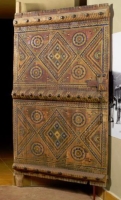
The Traditional Wooden Room Door is a heritage door crafted from tamarisk wood, featuring a single leaf. It dates back to the Saudi period. The door’s planks are joined together with three horizontal wooden beams. The door is adorned with repetitive geometric decorations, including interlocking diamonds, circles, triangles, and frames embellished with multicolored patterns, predominantly in red. The beams feature grooved decorations, with the upper and lower beams secured by eight dome-headed...
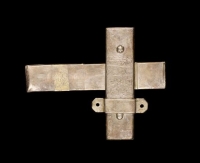
The Ancient Silver Lock for the Door of the Tomb of Prophet Muhammad is an ancient lock for the door of the Tomb of Prophet Muhammad, crafted from silver and inscribed with some verses, names, and prayers. Dimensions of the lock Length: 24.5 cm. Width: Twelve cm. Height: 2.5 cm. History of the lock The lock of the door of the Tomb of Prophet Muhammad dates back to the Ottoman period. It is considered one of the ornamental elements of doors due to its design. Its source is the General Presidency...
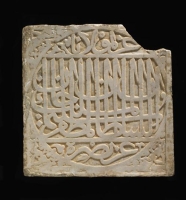
The Ancient Marble Foundation Stone is a square marble slab discovered in Makkah al-Mukarramah City . The slab is damaged at its upper left corner. It features an inscribed decorative band within a circle, surrounded by geometric patterns at its four edges. The inscription consists of three lines written in the Thuluth script. Measurements of the stone Length: Thirty-seven cm. Width: Thirty-seven cm. Thickness: Three cm. History of the stone The marble foundation stone dates back to the Ottoman...
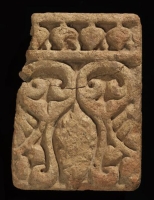
The Wall Tile is one of the artifacts selected to participate in the Saudi Archeological Masterpieces Through the Ages Exhibition, held at the Louvre Museum in the French capital, Paris, in 2010. The exhibition included three hundred pieces made of various materials and spanning different eras. These are original artifacts from various regions of the Kingdom of Saudi Arabia, classified chronologically into three groups: Pieces from prehistoric periods, pieces from pre-Islamic periods, and piece...
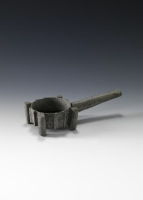
The Soapstone Censer is an ancient incense burner carved from soapstone, featuring a circular basin. It was discovered in the historic area of al-Rabadha, located about two hundred km east of al-Madinah al-Munawwarah , near the western Hejaz Mountains in the Kingdom of Saudi Arabia. Description of the censer The soapstone censer has four legs, each pair opposite one another, with each leg shaped like a triangle extending from the basin and reaching the ground. Additionally, four shapes are carv...
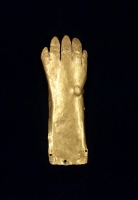
The Golden Palm and Arm is an artistic artifact consisting of a hand covering made of gold, featuring the palm and arm. The hand is depicted with the back of a small palm and fingers ending in triangular-shaped nails. The joints of the fingers are clearly visible, and the wrist appears wide. At the end of the wrist, three perforations are present, used to secure the model. It was discovered in the historic Thaj City , the largest archaeological site of the Hellenistic period in the eastern Arab...
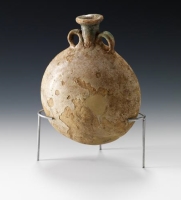
The Ceramic Flask is an ancient round flask, shaped like the back of a turtle. It was discovered in the archeological Qaryat al-Faw , the home of al-Faw civilization in the Arabian Peninsula. The village is located in the region where Wadi ad-Dawasir intersects with Tuwaiq Mountain range, near the mouth of a channel called al-Faw, in Wadi ad-Dawasir Governorate , in Riyadh Province of the Kingdom of Saudi Arabia. Description of the ceramic flask The ceramic flask was crafted from a pure yellow ...
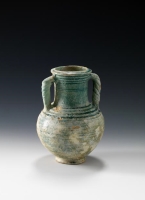
The Archaeological Ceramic Vase is a circular artifact made of coarse red clay. It was discovered in the archaeological Qaryat al-Faw , located at the intersection of ad-Dawasir Valley and Tuwaiq Mountain Range in Wadi ad-Dawasir Governorate , Riyadh Province , the Kingdom of Saudi Arabia. Description of the vase The archaeological ceramic vase features a long neck positioned at the center of the upper part of the jar. It has a rim with outwardly extending lips, and an additional set of lips lo...
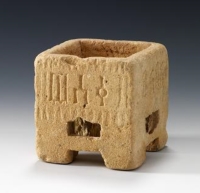
The Square Limestone Censer is a square-shaped incense burner carved from limestone, discovered in archaeological Qaryat al-Faw , located in the southeast Wadi ad-Dawasir Governorate in Riyadh Province of the Kingdom of Saudi Arabia. Description of the censer The square limestone censer consists of a deep basin with straight edges. One of the sides shows signs of breakage caused by an impact with a hard object. It is supported by four square legs carved at the lower corners, with bridges left b...
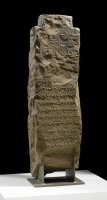
The Ancient Sandstone Stele from Tayma is a stele made of sandstone, discovered in al-Hamra Palace , located in Tayma Governorate , Tabuk Province , north of the Kingdom of Saudi Arabia. The stele dates back to the period between 555 BCE and 539 BCE. It is rectangular in shape, with a sculpted horizontal bar at the top and a roughly carved, irregular base at the bottom. Its surface is divided into two sections. The upper section contains symbolic carvings, including a winged sun disk on the lef...